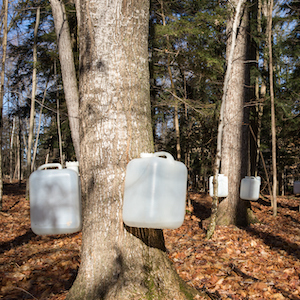Wisconsin Extension Maple Syrup Program
Program Overview
Supporting the future of maple syrup in Wisconsin
The Wisconsin Extension Maple Syrup Program is a new three-year project supported by the USDA Agricultural Marketing Service (AMS) through the Acer Access and Development Program.
Focus areas
- Supporting sustainable forest practices of maple syrup producers, especially relative to climate change adaptation strategies.
- Providing resources and support to foresters and other advisors who work with maple syrup producers.
- Better understanding and supporting the needs of tribal communities in Wisconsin related to maple syrup production.
Partnerships
Extension will partner with other statewide and regional organizations and programs to deliver the project including the Wisconsin Maple Syrup Producers Association, University of Minnesota Sustainable Forests Education Cooperative, UW-Stevens Point Wisconsin Forestry Center, Northern Institute of Applied Climate Science and the USDA Northern Forests Climate Hub.
Research
The research component of the program seeks to understand how Extension, foresters, equipment suppliers, and others can effectively support existing maple syrup producers in Wisconsin, as well as how they can encourage more Wisconsinites to begin producing maple syrup. In 2022, we worked with our partners to develop and run a comprehensive needs assessment survey. With responses from 677 maple producers, the survey examined the landscape of Wisconsin maple syrup production along with current opportunities and challenges.
We have published three academic journal articles analyzing data from the needs assessment. In November 2023, we ran a Facebook ad campaign testing how to effectively encourage non-producers to consider beginning maple syrup production. Visit our research page for more information.
Wisconsin maple syrup production
Wisconsin is currently fourth in the nation in maple syrup production, producing around 300,000 gallons of maple syrup at an annual value of around $9 million.
Wisconsin has 3.7 million acres of maple forests, and only a small fraction are currently being used for maple syrup production. As demand for maple syrup continues to grow nationally and internationally, there is great potential for growth in the industry.
Beyond the grant
UW–Madison Division of Extension hopes to be able to continue to support the maple syrup industry in the state beyond this initial project. Additional resources and research will be determined through this initial needs assessment and will be dependent upon available funding.

Information
Contact
Tricia Gorby
Email: tricia.gorby@wisc.edu
Related Website
Maple Syrup Program
Helpful Resources:
USDA 2022 Maple Crop Report (See pgs. 11-13)




